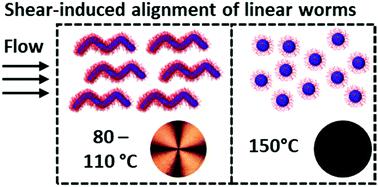当前位置:
X-MOL 学术
›
Soft Matter
›
论文详情
Our official English website, www.x-mol.net, welcomes your feedback! (Note: you will need to create a separate account there.)
Shear-induced alignment of block copolymer worms in mineral oil
Soft Matter ( IF 3.4 ) Pub Date : 2021-09-15 , DOI: 10.1039/d1sm01011e Matthew J Derry 1 , Oleksandr O Mykhaylyk 1 , Steven P Armes 1
Soft Matter ( IF 3.4 ) Pub Date : 2021-09-15 , DOI: 10.1039/d1sm01011e Matthew J Derry 1 , Oleksandr O Mykhaylyk 1 , Steven P Armes 1
Affiliation

|
Poly(stearyl methacrylate)–poly(benzyl methacrylate) [PSMA–PBzMA] diblock copolymer worms were synthesized directly in mineral oil via reversible addition–fragmentation chain transfer (RAFT) dispersion polymerization at 90 °C. Free-standing gels were obtained from this polymerization-induced self-assembly (PISA) formulation when targeting PSMA13–PBzMA65 dispersions at 5% w/w to 20% w/w copolymer concentration. Gel permeation chromatography (GPC) studies indicated that almost identical copolymer chains were obtained in all cases, while transmission electron microscopy (TEM) and small-angle X-ray scattering (SAXS) studies confirmed that highly anisotropic worms were formed with mean cross-sectional diameters of 11.9–13.1 nm. These worms undergo a thermoreversible worm-to-sphere transition on heating up to 150 °C. Rheological studies were conducted to characterize the shear rate- and concentration-dependent behaviour caused by this change in copolymer morphology, where the initial shear-thinning worm gels form spheres (i.e. a Newtonian fluid) on heating up to 150 °C. Complementary shear-induced polarized light imaging (SIPLI) experiments confirmed the formation of aligned linear worms under applied shear between 80 °C and 110 °C, with high-viscosity dispersions of branched worms being obtained at 20–60 °C and low-viscosity spheres being produced at 150 °C. This study informs the use of such block copolymer worms as rheology modifiers for non-polar oils, which is of potential interest for the automotive industry.
中文翻译:

矿物油中嵌段共聚物蠕虫的剪切诱导排列
聚(甲基丙烯酸硬脂酯)-聚(甲基丙烯酸苄酯)[PSMA-PBzMA]双嵌段共聚物蠕虫是在矿物油中通过可逆加成-断裂链转移(RAFT)分散聚合在 90°C 下直接合成的。当靶向 PSMA 13 –PBzMA 65时,从这种聚合诱导自组装 (PISA) 配方中获得独立凝胶5% w/w 至 20% w/w 共聚物浓度的分散体。凝胶渗透色谱 (GPC) 研究表明,在所有情况下都获得了几乎相同的共聚物链,而透射电子显微镜 (TEM) 和小角 X 射线散射 (SAXS) 研究证实,形成了具有平均横截面的高度各向异性蠕虫直径为 11.9–13.1 nm。这些蠕虫在加热到 150 °C 时会发生热可逆的蠕虫到球体的转变。进行流变学研究以表征由共聚物形态的这种变化引起的剪切速率和浓度依赖性行为,其中初始剪切稀化蠕虫凝胶形成球体(即牛顿流体)加热至 150 °C。互补剪切诱导偏振光成像 (SIPLI) 实验证实了在 80°C 和 110°C 之间的应用剪切下形成对齐的线性蠕虫,在 20-60°C 和低粘度下获得分支蠕虫的高粘度分散体球体在 150 °C 下生产。这项研究表明使用这种嵌段共聚物蠕虫作为非极性油的流变改性剂,这对汽车行业具有潜在的兴趣。
更新日期:2021-09-20
中文翻译:

矿物油中嵌段共聚物蠕虫的剪切诱导排列
聚(甲基丙烯酸硬脂酯)-聚(甲基丙烯酸苄酯)[PSMA-PBzMA]双嵌段共聚物蠕虫是在矿物油中通过可逆加成-断裂链转移(RAFT)分散聚合在 90°C 下直接合成的。当靶向 PSMA 13 –PBzMA 65时,从这种聚合诱导自组装 (PISA) 配方中获得独立凝胶5% w/w 至 20% w/w 共聚物浓度的分散体。凝胶渗透色谱 (GPC) 研究表明,在所有情况下都获得了几乎相同的共聚物链,而透射电子显微镜 (TEM) 和小角 X 射线散射 (SAXS) 研究证实,形成了具有平均横截面的高度各向异性蠕虫直径为 11.9–13.1 nm。这些蠕虫在加热到 150 °C 时会发生热可逆的蠕虫到球体的转变。进行流变学研究以表征由共聚物形态的这种变化引起的剪切速率和浓度依赖性行为,其中初始剪切稀化蠕虫凝胶形成球体(即牛顿流体)加热至 150 °C。互补剪切诱导偏振光成像 (SIPLI) 实验证实了在 80°C 和 110°C 之间的应用剪切下形成对齐的线性蠕虫,在 20-60°C 和低粘度下获得分支蠕虫的高粘度分散体球体在 150 °C 下生产。这项研究表明使用这种嵌段共聚物蠕虫作为非极性油的流变改性剂,这对汽车行业具有潜在的兴趣。



























 京公网安备 11010802027423号
京公网安备 11010802027423号